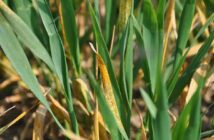Independent 2016 field trials have once again proven Syngenta’s powerful, new, SDHI fungicide, Solatenol, to deliver consistent yield results and exceptional disease control.
In extensive trial work carried out by ADAS, Prime Ag and Teagasc, this year, the independents have all confirmed the performance of Solatenol as an effective T2 fungicide.
Jason Tatnell, Syngenta’s technical indication expert, explains the results.
“Being a new active, Solatenol has been through vigorous trial work over several years, in which it has consistently proven itself in both high and low disease pressure years, across numerous field situations. The independent results this year have once again confirmed this.
“The intrinsic characteristic Solatenol has of providing complete leaf protection has really shone through this year, particularly with the high disease pressures we’ve seen,” adds Mr Tatnell.
“For example, in trial work ADAS has carried out this year, the direct correlation between green leaf area duration and yield response has clearly been seen.
“Solatenol outperformed competitor SDHIs in both the percentage green leaf area maintained on leaf one over a four week period, and delivered a 0.28t/ha yield average increase when compared to fluxapyroxad plus metconazole.”
Mr Tatnell also explains that trials carried out by Prime Ag, led by Tom McCabe, which looked specifically at Septoria tritici and brown rust control, found that Solatenol, when mixed with Bravo, had much better control of both diseases when compared to other fungicides.
“By the middle of July, this trial was showing that plots treated with Solatenol saw, on average, control of Septoria tritici at 75%, with brown rust up to 85% control, which was substantially above the control achieved by other fungicides trialled. This is really promising to see considering the season we’ve had,” he explains.
He also adds how the findings of the Irish field trials are a really valuable resource to prove the efficacy of Solatenol. “The variation in climate, and increased rainfall in Ireland compared to the UK, means the conditions often lead to much higher disease pressures than we experience, even in bad years.
“Hence, trial work over there really puts fungicides to the test, and acts as a sound testing ground for new actives,” he says.
During 2016, the team at Teagasc have looked at trials focusing on the importance of spray timings and which actives perform well together, within a programme. “From the results we’ve seen, it has really highlighted how applying a powerful SDHI at T2 can show real yield benefits.
“By applying bixafen plus prothioconazole at T1, followed by Solatenol at T2, a yield increase of 0.49t/ha was recorded when compared to bixafen plus prothioconazole followed by fluxapyroxad plus epoxiconazole,” he explains.
“We know that Solatenol is a class leading fungicide, through the extensive trial work we’ve carried out, and how it’s already performing in other countries.
“But to see this confirmed in 2016 independent trials brings to the forefront the potential Solatenol has for controlling key economically damaging diseases for UK growers,” says Mr Tatnell.




